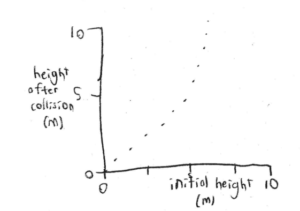Question: (12 points, suggested time 25 minutes)
A new kind of toy ball is advertised to “bounce perfectly elastically” off hard surfaces. A student suspects, however, that no collision can be perfectly elastic. The student hypothesizes that the collisions are very close to being perfectly elastic for low-speed collisions but that they deviate more and more from being perfectly elastic as the collision speed increases.
(a) Design an experiment to test the student’s hypothesis about collisions of the ball with a hard surface. The student has equipment that would usually be found in a school physics laboratory.
i. What quantities would be measured?
ii. What equipment would be used for the measurements, and how would that equipment be used?
iii. Describe the procedure to be used to test the student’s hypothesis. Give enough detail so that another student could replicate the experiment.
(b) Describe how you would represent the data in a graph or table. Explain how that representation would be used to determine whether the data are consistent with the student’s hypothesis.
(c) A student carries out the experiment and analysis described in parts (a) and (b). The student immediately concludes that something went wrong in the experiment because the graph or table shows behavior that is elastic for low-speed collisions but appears to violate a basic physics principle for high-speed collisions.
i. Give an example of a graph or table that indicates nearly elastic behavior for low-speed collisions but appears to violate a basic physics principle for high-speed collisions.
ii. State one physics principle that appears to be violated in the graph or table given in part (c)i. Several physics principles might appear to be violated, but you only need to identify one.
Briefly explain what aspect of the graph or table indicates that the physics principle is violated, and why.
▶️Answer/Explanation
Ans:
(a)
i.
height of boll before collision
height of boll after collision
ii.
A tape measure would be used to measure the height of the boll at its peak before and after the collision.
iii.
- Drop the ball at a height of 1 foot determined by tape measure and record height with the same tape measure.
- Repeat 3 times.
- Repeat 1 – 2 with heights 2ft, 3ft, 5ft, 10ft, and 15ft.
(b) The X axis would be the height dropped from and the Y axis would be the new height. If the collision is elastic the data should be linear at a lil ratio of the before and after heights. However, if the students hypothesis is correct the data should deviate downward from this trend line at higher heights because the greater the height the mole velocity produced upon collision.
(c)
i.

ii. conversation of energy is being violated because the ball is getting higher after the collision than from when it was dropped. Because mass and acceleration due to gravity are constant that means the ball gained more energy after the collision and did not conserve it.
Question

A car of known mass \(m_{1}\) will collide with a second car of known mass \(m_{2}\). The collision will be head on, and both cars will only move linearly both before and after the collision. In a clear, coherent, paragraph-length response, explain a method for determining whether the collision is perfectly elastic, perfectly inelastic, or neither. If the collision is perfectly inelastic, include at least one possible cause of energy loss.
▶️Answer/Explanation
Ans:
The defining characteristic of a perfectly elastic collision is that no kinetic energy is lost. Therefore, you must record the speeds of each car before and after the collision. Then, the equation \(\frac{1}{2}m_{1}v^{2}_{1,0}+\frac{1}{2}m_{1}v^{2}_{1,f}=\frac{1}{2}m_{2}v^{2}_{2,f}\) can be used to check whether or not it is elastic. The defining feature of a perfectly inelastic collision is that the objects stick together after the collision. This can be simply observed. If the two cars remain intact post-collision, then the collision is perfectly inelastic. If neither of the above is true, then it is neither perfectly elastic nor perfectly inelastic.
Finally, a few possible sources of energy loss would be the heat generated as metal is warped, the sound made by the crash, and even the light of any sparks generated.
Question

An experiment is conducted in which Block A with a mass of \(m_{A}\) is slid to the right across a frictionless table. Block A collides with Block B, which is initially at rest, of an unknown mass and sticks to it.
(a) Describe an experimental procedure that determines the velocities of the blocks before and after a collision. Include all the additional equipment you need. You may include a labeled diagram of your setup to help in your description. Indicate what measurements you would take and how you would take them. Include enough detail so that the experiment could be repeated with the procedure you provide.
(b) If Block A has a mass of 0.5 kg and starts off with a speed of 1.5 m/s and the experiment is repeated, the velocity of the blocks after the collide are recorded to be 0.25 m/s. What is the mass of Block B?
(c) How much kinetic energy was lost in this collision from part (b)?
▶️Answer/Explanation
Ans:
(a) One such example would be to mark off two distances on the table—one for Block A before the collision, and one for the combined blocks after the collision. Push Block A to give it an initial speed. Use a stopwatch to measure the time it takes for the blocks to cross the marked distances. The speeds are the distances divided by the time.
(b) \(m_{A}v_{i}=(m_{A}+m_{B})v_{f}\)
\(m_{B}=(\frac{m_{A}v_{i}}{v_{f}})=m_{A}=[\frac{(0.5kg)(1.5m/s)}{0.25m/s}]-0.5kg=2.5kg\)
(c) \(K_{initial}=\frac{1}{2}(0.5kg)(1.5m/s)^{2}=0.56J\)
\(K_{final}=\frac{1}{2}(3kg)(0.25m/s)^{2}=0.09J\)
The total kinetic energy lost is equal to
\(K_{initial}-K_{final}=0.56J-0.09J=0.47J\)
